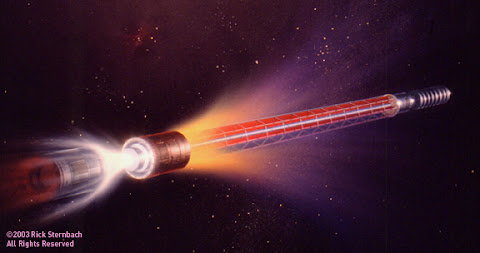Richard Michael Sternbach is an illustrator who is best known for his space illustrations and his work on the Star Trek television series. He has been a space and sci-fi artist since the early 1970s, often combining both interests in a project. He is a founding member and Fellow of the International Association of Astronomical Artists (IAAA), which was formed in 1981. He has written and illustrated articles on orbital transfer vehicles and interstellar flight for Science Digest. Beginning in the late 1970s Rick added film and television illustration and special effects to his background, with productions like "Star Trek: The Motion Picture", "The Last Starfighter", "Future Flight", and "Cosmos", for which he and other members of the astronomical art team received an Emmy award, the first for visual effects. Rick Sternbach also twice received the coveted Hugo award for best professional science fiction artist, in 1977 and 1978. Below are some examples of Rick Sternbach's original space paintings with artist description.
Note: All artwork and images copyright © Rick Sternbach. Please do not use images without the permission.

Bussard Ramjet (Science Digest, May 1983), illustrating my article on the then-current situation in interstellar studies. In 1960 Dr. Robert Bussard theorized that spacecraft fuel could be gathered up en route using strong magnetic fields. In 1983 he sat in my living room and sketched up this design, which features a multilayer forward scattershield, habitat modules, radiator tower, and ramscoop engine. The ship is seen dropping off its unmanned deuterium fusion booster after reaching 1000 kilometers per second velocity.

Refueling Station I wrote and illustrated an article for the May 1983 issue of Science Digest which examined the "state of the art" of interstellar exploration schemes. The article also featured sidebar pieces by two of the prominent thinkers in the field, Dr. Robert Forward and Dr. Robert Bussard.This painting depicts a ship imagined by the third "Bob" in the interstellar game, Dr. Robert Enzmann, as it arrives in a new star system. The icy moons of this gas giant may provide a new fuel source for the ship's fusion engines.

Voyager FoundPrivate commission. Imagine a combined human-dolphin crew heading out to find Voyager 1 and bring it home to the Smithsonian. Imagine their surprise when they discover the gold "greetings from Earth" record and playback stylus are -gone-. Their ship is not a true interstellar spacecraft, but the precursor of one; a far extrasolar explorer powered by early laser-induced fusion engines. I'd send dolphins to do EVA only if they want to go; we do 3D moves pretty well; maybe they do them better.

Space Doctor (Novel by G. Harry Stine writing as Lee Correy, Del Rey Books). An ambulance module tears away from an orbital worksite accident in this story of the dangers of space construction. In the 1970s, some imaged that large space-based solar arrays would be beaming cheap energy to Earth by now. Located at GEO 22,500 miles up, orbiting medical facilities would be required along with habitats; it is assumed that returning to Earth might take too long or the g-load could prove more harmful to the patient than staying in microgravity.

Earth Moon Halley This painting from the book COMET by Dr. Carl Sagan and Ann Druyan depicts Comet Halley during its passge through the inner solar system in 1910. During this time, the comet's ion tail may have grazed the Earth.
Official website: Rick Sternbach Studio
Wikipedia: Rick Sternbach
Internet Speculative Fiction Database: Rick Sternbach Bibliography
Rick Sternbach at Memory Alpha
SebRT.com: Interview with Rick Sternbach





